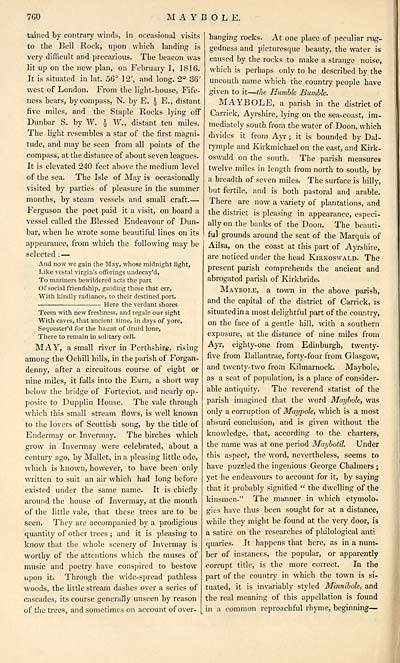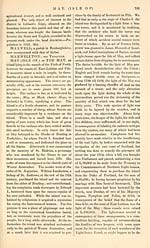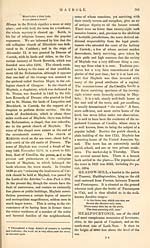Gazetteer of Scotland > Volume 2
(276) Page 760 - MAY
Download files
Complete book:
Individual page:
Thumbnail gallery: Grid view | List view

760
M A Y J3 O L E.
tained by contrary winds, in occasional visits
to the Bell Rock, upon which landing is
very difficult and precarious. The beacon was
lit up on the new plan, on February 1, 1816.
It is situated in lat. 56° 12', and long. 2° 36'
west of London. From the light-house, Fife-
ness bears, by compass, N. by E. \ E., distant
five miles, and the Staple Rocks lying off
Dunbar S. by W. ^ W., distant ten miles.
The light resembles a star of the first magni-
tude, and may be seen from all points of the
compass, at the distance of about seven leagues.
It is elevated 240 feet above the medium level
of the sea. The Isle of May is occasionally
visited by parties of pleasure in the summer
months, by steam vessels and small craft
Ferguson the poet paid it a visit, on board a
vessel called the Blessed Endeavour of Dun-
bar, when he wrote some beautiful lines on its
appearance, from which the following may be
selected : —
And now we gain the May, whose midnight light,
Like vestal virgin's offerings undecay'd,
To mariners bewildered acts the part
Of social friendship, guiding those that err,
With kindly radiance, to their destined port.
■ Here the verdant shores
Teem with new freshness, and regale our sight
With caves, that ancient time, in days of yore,
Sequester' d for the haunt of druid lone.
There to remain in solitary cell.
MAY, a small river in Perthshire, rising
among the Ochill hills, in the parish of Forgan-
denny, after a circuitous course of eight or
nine miles, it Mis into the Earn, a short way
below the bridge of Forteviot, and nearly op-
posite to Dupplin House. The vale through
which this small stream flows, is well known
to the lovers of Scottish song, by the title of
Endermay or Invermay. The birches which
grow in Invermay were celebrated, about a
century ago, by Mallet, in a pleasing little ode,
which is known, however, to have been only
written to suit an air which had long before
existed under the same name. It is chiefly
around the house of Invermay, at the mouth
of the little vale, that these trees are to be
seen. They are accompanied by a prodigious
quantity of other trees ; and it is pleasing to
know that the whole scenery of Invermay is
worthy of the attentions which the muses of
music and poetry have conspired to bestow
upon it. Through the wide-spread pathless
woods, the little stream dashes over a series of
cascades, its course generally unseen by reason
of the trees, and sometimes on account of over-
hanging rocks. At one place of peculiar rug-
gedness and picturesque beauty, the water is
caused by the rocks to make a strange noise,
which is perhaps only to be described by the
uncouth name which the country people have
given to it— the Humble Bumble.
MAYBOLE, a parish in the district of
Carrick, Ayrshire, lying on the sea-coast, im-
mediately south from the water of Doon, which
divides it from Ayr ; it is bounded by Dal-
rymple and Kirkmichael on the east, and Kirk-
oswald on the south. The parish measures
twelve miles in length from north to south, by
a breadth of seven miles. The surface is hilly,
but fertile, and is both pastoral and arable.
There are now a variety of plantations, and
the district is pleasing in appearance, especi-
ally on the banks of the Doon. The beauti-
ful grounds around the seat of the Marquis of
Ailsa, on the coast at this part of Ayrshire,
are noticed under the head Kirkoswald. The
present parish comprehends the ancient and
abrogated parish of Kirkbride.
Maybole, a town in the above parish,
and the capital of the district of Carrick, is
situatedin a most delightful part of the country,
on the face of a gentle hill, with a southern
exposure, at the distance of nine miles from
Ayr, eighty-one from Edinburgh, twenty-
five from Ballantrae, forty-four from Glasgow,
and twenty-two from Kilmarnock. Maybole,
as a seat of population, is a place of consider-
able antiquity. The reverend statist of the
parish imagined that the wofd Maybole, was
only a corruption of Maypole, which is a most
absurd conclusion, and is given without the
knowledge, that, according to the charters,
the name was at one period Maybotil. Under
this aspect, the word, nevertheless, seems to
have puzzled the ingenious George Chalmers ;
yet he endeavours to account for it, by saying
that it probably signified " the dwelling of the
kinsmen." The manner in which etymolo-
gies have thus been sought for at a distance,
while they might be found at the very door, is
a satire on the researches of philological anti
quaries. It happens that here, as in a num-
ber of instances, the popular, or apparently
corrupt title, is the more correct. In the
part of the country in which the town is si-
tuated, it is invariably styled Minnibole, and
the real meaning of this appellation is found
in a common reproachful rhyme, beginning —
M A Y J3 O L E.
tained by contrary winds, in occasional visits
to the Bell Rock, upon which landing is
very difficult and precarious. The beacon was
lit up on the new plan, on February 1, 1816.
It is situated in lat. 56° 12', and long. 2° 36'
west of London. From the light-house, Fife-
ness bears, by compass, N. by E. \ E., distant
five miles, and the Staple Rocks lying off
Dunbar S. by W. ^ W., distant ten miles.
The light resembles a star of the first magni-
tude, and may be seen from all points of the
compass, at the distance of about seven leagues.
It is elevated 240 feet above the medium level
of the sea. The Isle of May is occasionally
visited by parties of pleasure in the summer
months, by steam vessels and small craft
Ferguson the poet paid it a visit, on board a
vessel called the Blessed Endeavour of Dun-
bar, when he wrote some beautiful lines on its
appearance, from which the following may be
selected : —
And now we gain the May, whose midnight light,
Like vestal virgin's offerings undecay'd,
To mariners bewildered acts the part
Of social friendship, guiding those that err,
With kindly radiance, to their destined port.
■ Here the verdant shores
Teem with new freshness, and regale our sight
With caves, that ancient time, in days of yore,
Sequester' d for the haunt of druid lone.
There to remain in solitary cell.
MAY, a small river in Perthshire, rising
among the Ochill hills, in the parish of Forgan-
denny, after a circuitous course of eight or
nine miles, it Mis into the Earn, a short way
below the bridge of Forteviot, and nearly op-
posite to Dupplin House. The vale through
which this small stream flows, is well known
to the lovers of Scottish song, by the title of
Endermay or Invermay. The birches which
grow in Invermay were celebrated, about a
century ago, by Mallet, in a pleasing little ode,
which is known, however, to have been only
written to suit an air which had long before
existed under the same name. It is chiefly
around the house of Invermay, at the mouth
of the little vale, that these trees are to be
seen. They are accompanied by a prodigious
quantity of other trees ; and it is pleasing to
know that the whole scenery of Invermay is
worthy of the attentions which the muses of
music and poetry have conspired to bestow
upon it. Through the wide-spread pathless
woods, the little stream dashes over a series of
cascades, its course generally unseen by reason
of the trees, and sometimes on account of over-
hanging rocks. At one place of peculiar rug-
gedness and picturesque beauty, the water is
caused by the rocks to make a strange noise,
which is perhaps only to be described by the
uncouth name which the country people have
given to it— the Humble Bumble.
MAYBOLE, a parish in the district of
Carrick, Ayrshire, lying on the sea-coast, im-
mediately south from the water of Doon, which
divides it from Ayr ; it is bounded by Dal-
rymple and Kirkmichael on the east, and Kirk-
oswald on the south. The parish measures
twelve miles in length from north to south, by
a breadth of seven miles. The surface is hilly,
but fertile, and is both pastoral and arable.
There are now a variety of plantations, and
the district is pleasing in appearance, especi-
ally on the banks of the Doon. The beauti-
ful grounds around the seat of the Marquis of
Ailsa, on the coast at this part of Ayrshire,
are noticed under the head Kirkoswald. The
present parish comprehends the ancient and
abrogated parish of Kirkbride.
Maybole, a town in the above parish,
and the capital of the district of Carrick, is
situatedin a most delightful part of the country,
on the face of a gentle hill, with a southern
exposure, at the distance of nine miles from
Ayr, eighty-one from Edinburgh, twenty-
five from Ballantrae, forty-four from Glasgow,
and twenty-two from Kilmarnock. Maybole,
as a seat of population, is a place of consider-
able antiquity. The reverend statist of the
parish imagined that the wofd Maybole, was
only a corruption of Maypole, which is a most
absurd conclusion, and is given without the
knowledge, that, according to the charters,
the name was at one period Maybotil. Under
this aspect, the word, nevertheless, seems to
have puzzled the ingenious George Chalmers ;
yet he endeavours to account for it, by saying
that it probably signified " the dwelling of the
kinsmen." The manner in which etymolo-
gies have thus been sought for at a distance,
while they might be found at the very door, is
a satire on the researches of philological anti
quaries. It happens that here, as in a num-
ber of instances, the popular, or apparently
corrupt title, is the more correct. In the
part of the country in which the town is si-
tuated, it is invariably styled Minnibole, and
the real meaning of this appellation is found
in a common reproachful rhyme, beginning —
Set display mode to: Large image | Transcription
Images and transcriptions on this page, including medium image downloads, may be used under the Creative Commons Attribution 4.0 International Licence unless otherwise stated. ![]()
| Gazetteers of Scotland, 1803-1901 > Gazetteer of Scotland > Volume 2 > (276) Page 760 - MAY |
|---|
| Permanent URL | https://digital.nls.uk/97434134 |
|---|
| Description | Volume II: Glenbanchor to Zetland. |
|---|---|
| Attribution and copyright: |
|
| Description | By Robert Chambers and William Chambers. Glasgow: Blackie & Son, 1838. 2 volumes. |
|---|---|
| Shelfmark | NF.1461.g.7 |
| Additional NLS resources: | |

